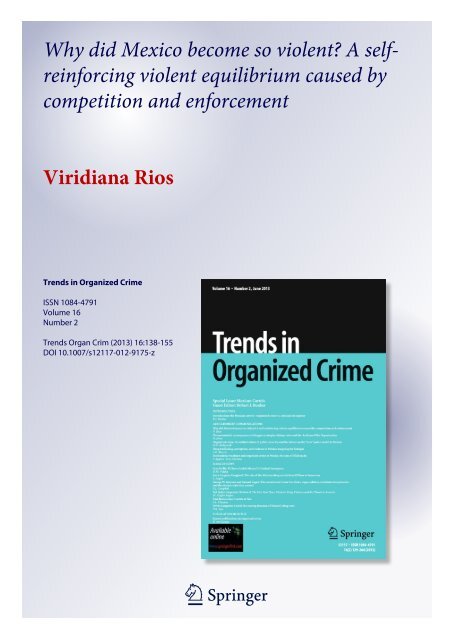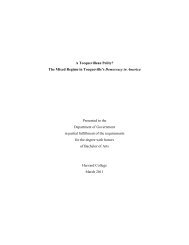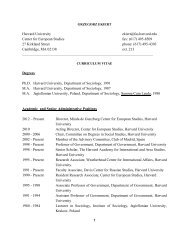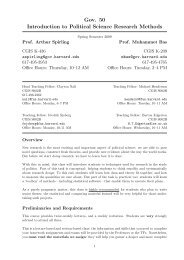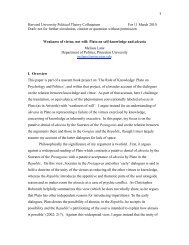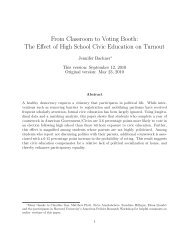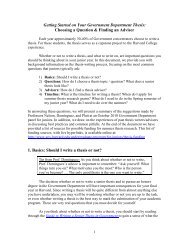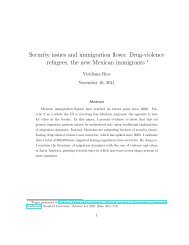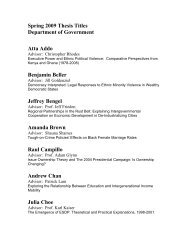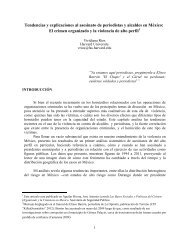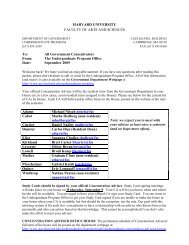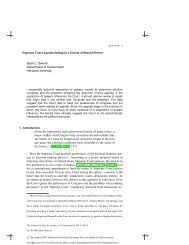Why did Mexico become so violent? - Department of Government ...
Why did Mexico become so violent? - Department of Government ...
Why did Mexico become so violent? - Department of Government ...
Create successful ePaper yourself
Turn your PDF publications into a flip-book with our unique Google optimized e-Paper software.
<strong>Why</strong> <strong>did</strong> <strong>Mexico</strong> <strong>become</strong> <strong>so</strong> <strong>violent</strong>? A selfreinforcing<br />
<strong>violent</strong> equilibrium caused by<br />
competition and enforcement<br />
Viridiana Rios<br />
Trends in Organized Crime<br />
ISSN 1084-4791<br />
Volume 16<br />
Number 2<br />
Trends Organ Crim (2013) 16:138-155<br />
DOI 10.1007/s12117-012-9175-z<br />
1 23
Your article is protected by copyright and<br />
all rights are held exclusively by Springer<br />
Science+Business Media, LLC. This e-<strong>of</strong>fprint<br />
is for per<strong>so</strong>nal use only and shall not be selfarchived<br />
in electronic repositories. If you wish<br />
to self-archive your article, please use the<br />
accepted manuscript version for posting on<br />
your own website. You may further deposit<br />
the accepted manuscript version in any<br />
repository, provided it is only made publicly<br />
available 12 months after <strong>of</strong>ficial publication<br />
or later and provided acknowledgement is<br />
given to the original <strong>so</strong>urce <strong>of</strong> publication<br />
and a link is inserted to the published article<br />
on Springer's website. The link must be<br />
accompanied by the following text: "The final<br />
publication is available at link.springer.com”.<br />
1 23
Author's per<strong>so</strong>nal copy<br />
Trends Organ Crim (2013) 16:138–155<br />
DOI 10.1007/s12117-012-9175-z<br />
<strong>Why</strong> <strong>did</strong> <strong>Mexico</strong> <strong>become</strong> <strong>so</strong> <strong>violent</strong>? A self-reinforcing<br />
<strong>violent</strong> equilibrium caused by competition<br />
and enforcement<br />
Viridiana Rios<br />
Published online: 9 August 2012<br />
# Springer Science+Business Media, LLC 2012<br />
Abstract This article explains why homicides related to drug-trafficking operations in<br />
<strong>Mexico</strong> have recently increased by exploring the mechanisms through which this type <strong>of</strong><br />
violence tends to escalate. It is shown that drug-related violence can be understood as the<br />
result <strong>of</strong> two factors: (a) homicides caused by traffickers battling to take control <strong>of</strong> a<br />
competitive market, and (b) casualties and arrests generated by law enforcement<br />
operations against traffickers. Both <strong>so</strong>urces <strong>of</strong> violence interact causing <strong>Mexico</strong> to be<br />
locked into a “self-reinforcing <strong>violent</strong> equilibrium” in which incremental increases in<br />
traffickers’ confrontations raise the incentives <strong>of</strong> the government to prosecute traffickers<br />
which promote further confrontations with traffickers when, as a result <strong>of</strong> the detention<br />
<strong>of</strong> drug lords, the remnants <strong>of</strong> the criminal organization fight each other in successive<br />
battles. This article presents quantitative evidence and case studies to assess the importance<br />
<strong>of</strong> the two mechanisms. It uses a unique dataset <strong>of</strong> recorded communications<br />
between drug traffickers and statistics on drug-related homicides.<br />
Keywords Competition . Crime . Drugs . Drug-related violence . Drug trafficking .<br />
Enforcement . Equilibrium . <strong>Mexico</strong> . Organized crime . Self-reinforcing . Violence<br />
Policemen, you do not understand. You pigs are helping them arrive first, to<br />
keep their houses <strong>so</strong> these nasty bandits can kidnap and shoot families. Now I<br />
will kill you all. You will see how it feels. An eye for an eye, a tooth for a<br />
tooth. 1<br />
1 Message left next to the body <strong>of</strong> the municipal police <strong>of</strong>ficer José Ángel Martínez. He was killed when<br />
waiting for the bus to go to work. Beside the message, a picture <strong>of</strong> a pig was left at the crime scene (Rios<br />
2012a).<br />
V. Rios (*)<br />
<strong>Department</strong> <strong>of</strong> <strong>Government</strong>, Harvard University, 1737 Cambridge Street CGIS -North, Cambridge,<br />
MA 02138, USA<br />
e-mail: vrios@fas.harvard.edu
Author's per<strong>so</strong>nal copy<br />
Trends Organ Crim (2013) 16:138–155 139<br />
A wave <strong>of</strong> drug-related violence has hit <strong>Mexico</strong>. From December 2006 to June<br />
2010, 41,648 killings have been <strong>of</strong>ficially linked to drug trafficking organizations, a<br />
dramatic increase from previous years (2001–2006) when only 8,901 killings were<br />
linked to organized crime (Rios and Shirk 2011). In 2010, drug-related homicides<br />
reached the record figure <strong>of</strong> 15,273 victims, making organized crime <strong>of</strong>ficially<br />
responsible for 45 % <strong>of</strong> all intended homicides in the country (Rios and Shirk<br />
2011). As a result, Mexican cities like Ciudad Juárez – a crucial trans-shipment point<br />
for the introduction <strong>of</strong> cocaine into the US – exhibited homicide rates <strong>of</strong> 216 victims<br />
per 100,000 inhabitants in 2010, a casualty rate that is comparable to that <strong>of</strong> war<br />
zones.<br />
The escalation <strong>of</strong> drug-related violence within <strong>Mexico</strong> is a puzzle. The country had<br />
long been a supplier <strong>of</strong> illegal drugs without this business causing any significant<br />
violence. Since at least 1994, <strong>Mexico</strong> took the place <strong>of</strong> Colombia as the most<br />
important point <strong>of</strong> entry <strong>of</strong> illegal drugs into the US, supplying about 70 % <strong>of</strong> the<br />
cocaine, 80 % <strong>of</strong> the marijuana, and 30 % <strong>of</strong> the heroine consumed in the country<br />
(Andreas 1998). <strong>Mexico</strong> was home to an illegal business generating billions <strong>of</strong><br />
dollars – and employing at least 5,000 armed actors – which until recently operated<br />
under a functional, non-<strong>violent</strong> equilibrium. 2 The way in which drug-related homicides<br />
spun out <strong>of</strong> control after 2006 cries for an explanation. The goal <strong>of</strong> this paper is<br />
to provide it.<br />
The argument has two parts. First, it will be shown that drug-related violence is<br />
caused by two mechanisms: (1) traffickers battling for turf to control competitive<br />
markets (“competition”), and (2) government efforts to reduce drug trafficking<br />
operations (“enforcement”). Second, it will be illustrated that these two mechanisms<br />
have interacted to lock <strong>Mexico</strong> into a “self-reinforcing <strong>violent</strong> equilibrium.” In<br />
particular, pro<strong>of</strong> will be presented on how battles for turf increase the incentives <strong>of</strong><br />
the government to enforce the law, which further increase battles for turf. Violence is<br />
self-reinforced because after the prosecution <strong>of</strong> criminal leaders, incentives are<br />
generated for the remnants <strong>of</strong> the criminal organization to keep battling, this time<br />
to select a new leader. The argument is supported by a unique dataset <strong>of</strong> communications<br />
between drug trafficking organizations as well as by quantitative data on<br />
drug-related homicides.<br />
This article flows in four sections. First, trends in <strong>Mexico</strong>’s drug-related homicides<br />
are described, emphasizing the temporal, geographic, and qualitative characteristics<br />
<strong>of</strong> these trends. This section al<strong>so</strong> provides an overview <strong>of</strong> the ways that the current<br />
literature has explained these trends, and on how the approach adopted here departs<br />
from the conventional accounts. Second, the ingredients <strong>of</strong> drug-related violence are<br />
explained in terms <strong>of</strong> competition and enforcement and the ways in which these<br />
mechanisms interact to generate a self-reinforcing <strong>violent</strong> equilibrium. In section<br />
three, a simple quantitative test to assess the contribution <strong>of</strong> each ingredient <strong>of</strong> drugrelated<br />
violence is presented, along with case studies to show the mechanics <strong>of</strong> the<br />
self-reinforcing <strong>violent</strong> equilibrium. Turf wars emerge when monopolistic control <strong>of</strong><br />
territories by drug-trafficking organizations is broken, when territories <strong>become</strong> competitive<br />
and traffickers fight for them. Through an analysis <strong>of</strong> the areas <strong>of</strong> operation <strong>of</strong><br />
2 Author interview with anonymous <strong>of</strong>ficial <strong>of</strong> <strong>Mexico</strong>’s main intelligence agency, the Center for Research<br />
and National Security (Centro de Investigación y Seguridad Nacional, CISEN).
Author's per<strong>so</strong>nal copy<br />
140 Trends Organ Crim (2013) 16:138–155<br />
one cartel, La Familia – the states <strong>of</strong> Michoacán, Guanajuato, and Guerrero – a fourth<br />
section demonstrates how the origins <strong>of</strong> regional spikes in violence can be traced to<br />
battles for specific pieces <strong>of</strong> turf. This section al<strong>so</strong> shows how law enforcement<br />
operations contribute to violence, following the logic mentioned above. The conclusion<br />
summarizes the argument and discusses several structural rea<strong>so</strong>ns that have<br />
changed the propensity <strong>of</strong> the government to enforce the law. It al<strong>so</strong> outlines the<br />
incentives <strong>of</strong> trafficking organizations to invade rival territories and break monopolistic<br />
operations. 3<br />
<strong>Mexico</strong>’s drug-related violence: trends and puzzles<br />
<strong>Mexico</strong>’s homicide rates have increased every year since at least 2006 (Fig. 1). The<br />
major increase in violence came after a dramatic spike in 2008, when organized crime<br />
related homicides jumped from 2,826 to 6,837 killings, a 142 % surge in compari<strong>so</strong>n<br />
to the prior year. After another increase <strong>of</strong> more than 40 %, reaching 9,614 killings in<br />
2009, the number <strong>of</strong> killings linked to organized crime jumped another 59 % in 2010.<br />
Violence does not spread homogeneously over <strong>Mexico</strong> but is highly concentrated<br />
in only a few regions. Since December 2006, 4 <strong>of</strong> 32 Mexican states accounted for<br />
84 % <strong>of</strong> all murders. Variations in the levels <strong>of</strong> violence concentration are even more<br />
pronounced at the municipal level: approximately 40 % <strong>of</strong> all organized crime<br />
killings had occurred in just 10 <strong>of</strong> the country’s roughly 2,450 municipalities. The<br />
next 90 most <strong>violent</strong> municipalities accounted for another 32 % <strong>of</strong> the violence, while<br />
the rest <strong>of</strong> the country accounted for only 28 %. The top five most <strong>violent</strong> municipalities<br />
— Ciudad Juárez, Culiacán, Tijuana, Chihuahua, and Acapulco — accounted<br />
for 12,070 homicides. Since 2006, over half <strong>of</strong> all homicides occurred in Ciudad<br />
Juárez, a municipality <strong>of</strong> about 1.38 million inhabitants.<br />
Furthermore, an analysis <strong>of</strong> these trends within individual states shows that drugrelated<br />
homicide rates are not homogenously increasing (Fig. 2). It is true that <strong>so</strong>me<br />
states like Chihuahua, Sinaloa, and Guerrero — and to a lesser extent Durango and<br />
Colima — have increased levels <strong>of</strong> violence every year. However, many others have<br />
experienced abrupt explosions <strong>of</strong> violence to <strong>so</strong>on return to a relative calm. For<br />
example, in November 2008 Tijuana experienced a dramatic increase in drug related<br />
violence and from then on, it went from having 15 to 215 cases <strong>of</strong> drug-related<br />
homicides per month. In retrospect, the violence was <strong>of</strong> very short duration: just<br />
3 months later, in February 2009, Tijuana returned to an average <strong>of</strong> only 11 drugrelated<br />
casualties per month.<br />
3 An important question remains as to why, if enforcement operations were conducted before 2006 (Chabat<br />
2010), these <strong>did</strong> not generated fragmentation in the same way in which enforcement operations <strong>did</strong> during<br />
the 2006–2010 period. The answer, explored by Rios (2012b), is to be found in the way in which <strong>Mexico</strong>’s<br />
informal political institutions have changed over the course <strong>of</strong> the years, particularly on how corruption<br />
changed from being a centralized to a decentralized game. Explaining historical patterns <strong>of</strong> drug-related<br />
violence is not the goal <strong>of</strong> this article. It suffices to say that previous to 2006, cohesiveness within the<br />
criminal world was indirectly enforced because corruption was largely centralized in the hands <strong>of</strong> a single,<br />
cohesive hegemonic party. Decentralization changed the rules <strong>of</strong> corruption, allowing criminal groups to<br />
engage in criminal operations with different parties and thus, indirectly changed the incentives that criminal<br />
organizations had to remain cohesive.
Author's per<strong>so</strong>nal copy<br />
Trends Organ Crim (2013) 16:138–155 141<br />
Fig. 1 Drug-related homicides in <strong>Mexico</strong>. Source Rios and Shirk 2011<br />
The current academic literature relies on structural variables as their main explanatory<br />
tools to explain incremental increases in drug-related violence. The generic<br />
story found in the main scholarly interpretations argues that during the 1980s,<br />
<strong>Mexico</strong>’s authoritarian, single-party political system enabled corrupt Mexican government<br />
<strong>of</strong>ficials to play a mediating and regulatory role with drug-trafficking<br />
organizations and to explicitly discourage violence. Mexican authorities implicitly<br />
agreed on allowing traffickers to continue their businesses as long as a quota <strong>of</strong> bribes<br />
was paid and no major epi<strong>so</strong>des <strong>of</strong> violence occurred (Paternostro 1995; Valle 1995;<br />
Gómez 2005; Guerrero2009). When state and local electoral victories brought<br />
politicians from opposing parties into power starting in the 1990s, previously established<br />
bargains with the drug-trafficking organizations were rejected or renegotiated<br />
by new, independent political actors who lacked the connections or ability to enforce<br />
previously established corruption agreements (Bailey and God<strong>so</strong>n 2000; Astorga<br />
2005; Davis 2006; Flores Pérez 2009; O’Neil 2009; Snyder and Duran-Martinez<br />
2009; Astorga and Shirk 2010; Chabat 2010). In this context <strong>of</strong> political diversity and<br />
uncertainty, the state no longer served as an effective mediator, and criminal organizations<br />
began to splinter and battle each other for turf.<br />
This article contributes to the explanation <strong>of</strong> drug-related violence given in this<br />
literature by explaining the drug war at the micro level. It analyzes why, despite the<br />
fact that democratization affected <strong>Mexico</strong> as a whole, drug-related violence is<br />
concentrated in only a handful <strong>of</strong> states, shifts significantly over time, and happens<br />
in apparently chaotic patterns. Furthermore, it provides an analytical narrative to<br />
Fig. 2 Drug-related homicides, geographic and time variability. Source CSN 2010
Author's per<strong>so</strong>nal copy<br />
142 Trends Organ Crim (2013) 16:138–155<br />
explain why, on the aggregate, drug-related homicides have increased and escalated<br />
more than ever before in <strong>Mexico</strong>. 4<br />
<strong>Why</strong> <strong>did</strong> <strong>Mexico</strong> <strong>become</strong> <strong>violent</strong>? A self-reinforcing <strong>violent</strong> equilibrium caused<br />
by competition and enforcement<br />
Two variables explain the geographic location and timing <strong>of</strong> drug-related violence:<br />
(1) the emergence <strong>of</strong> battles for turf between trafficking organizations competing for<br />
territories, here referred as “competition,” and (2) law enforcement operations, here<br />
referred as “enforcement.”<br />
First, battles for turf happen when the illegal drug industry changes from being<br />
oligopolistic — for example when a single drug trafficking organization controls a<br />
geographical area — to being competitive. Here competition refers to the presence <strong>of</strong><br />
two or more trafficking organizations distributing or trafficking drugs through a single<br />
territory. Competition is inherently unstable for illegal industries because these industries<br />
lack formal mechanisms and systematic rules to deal with disputes and disagreements<br />
between organizations. Traffickers dislike sharing territories because it increases the costs<br />
<strong>of</strong> corruption, reduces the share <strong>of</strong> the local market that it can supply, and makes<br />
production inputs scarce. For example, competition diminishes the ability <strong>of</strong> the original<br />
criminal organization to sell protection and rights within the territory. In short, with regard<br />
to incremental increases in competition as a driver <strong>of</strong> drug-related violence, the argument<br />
explored here is that violence increases when a new organization tries to conquer the<br />
territory <strong>of</strong> another, or when an organization splits causing internal confrontation.<br />
Second, government prosecution actions increase violence when traffickers and<br />
authorities confront and attack each other. The deployment <strong>of</strong> the army or special police<br />
forces to prosecute drug traffickers and to enforce the law in areas with strong presence<br />
<strong>of</strong> trafficking organizations increases drug-related violence by generating casualties<br />
either within the police or within criminal organizations. When these two factors occur<br />
simultaneously, when the two factors generate the fragmentation <strong>of</strong> drug-trafficking<br />
organizations, drug-related violence escalates. <strong>Mexico</strong> is currently submerged in a<br />
seemingly endless increase <strong>of</strong> drug-related violence because these two variables have<br />
interacted, placing <strong>Mexico</strong> into a “self-reinforcing <strong>violent</strong> equilibrium.”<br />
The self-reinforcing <strong>violent</strong> equilibrium begins (Fig. 3) when battles for turf result<br />
in outbreaks <strong>of</strong> drug-related homicides. The spread <strong>of</strong> this type <strong>of</strong> violence affects the<br />
electorate, and generates pressures within the political system to prosecute those who<br />
are elevating homicide rates. Enforcement operations in charge <strong>of</strong> reestablishing the rule<br />
<strong>of</strong> law are then conducted with the hope that in the long-run, enforcement will weaken<br />
drug-trafficking organizations enough to inhibit their operations and ability to initiate<br />
future <strong>violent</strong> acts. Yet, in the short-run, enforcement actually triggers violence by<br />
further increasing battles for turf. In each cycle <strong>of</strong> interaction, violence grows. 5<br />
4 It is important to mention that the explanation provided within this article applies only to the period here<br />
explored (i.e. 2006 -2010) and not to previous, historical periods. For a more comprehensive understanding<br />
<strong>of</strong> the rea<strong>so</strong>ns behind violence escalation or containment refer to Rios (2012a, b).<br />
5 Note that the equilibrium here described is not a closed and steady interaction <strong>of</strong> variables but a growing<br />
tendency that is self-catalytic. “Equilibrium” as described in this piece, should be understood as a<br />
progressive state, not as a steady state.
Author's per<strong>so</strong>nal copy<br />
Trends Organ Crim (2013) 16:138–155 143<br />
Fig. 3 Self-reinforcing <strong>violent</strong> equilibrium<br />
The mechanism which leads enforcement operations to close the self-enforced<br />
violence loop is simple. When enforcement leads to the capture or assassination <strong>of</strong> an<br />
important trafficker, drug trafficking organizations face two important problems.<br />
First, leadership succession rules within criminal organizations are far from established,<br />
which means an internal battle between drug-trafficking organizations’ potential<br />
succes<strong>so</strong>rs will almost surely ensue. Second, even if succession is not an issue,<br />
recovering the contacts and expertise <strong>of</strong> the captured or dead trafficker in order to<br />
keep the business running can immediately <strong>become</strong> a crucial issue if this information<br />
had not been previously shared with a leader’s potential succes<strong>so</strong>rs. In illegal businesses<br />
where contract enforcement is achieved through informal mechanisms, per<strong>so</strong>nal<br />
relationships play a central role in establishing and maintaining trust between<br />
trade partners. Internal agreements such as corruption pacts and alliances are normally<br />
based on prior per<strong>so</strong>nal ties. Per<strong>so</strong>nal links, long-term relationships, and other<br />
forms <strong>of</strong> <strong>so</strong>cial capital play a crucial role. A new leader may find it difficult to keep<br />
pre-existing agreements in place, which results in reduced pr<strong>of</strong>its and schisms within<br />
the organization.<br />
In the following section, an empirical analysis is presented, supported by case<br />
studies, to test the impact that competition and law enforcement have in the generation<br />
<strong>of</strong> drug-related violence.<br />
Empirical test<br />
To empirically test the contribution that competition and prosecution have in<br />
the generation <strong>of</strong> drug related violence, a simple test is conducted to assess the<br />
relationship that confrontations between trafficking organizations, or between<br />
trafficking organizations and Mexican authorities, have with the number <strong>of</strong><br />
drug-related targeted executions. This test is complemented by narratives from<br />
three case studies in the following section: Michoacán, Guanajuato, and<br />
Guerrero.<br />
The most reliable <strong>of</strong>ficial <strong>so</strong>urce <strong>of</strong> information on drug-related homicides is<br />
<strong>Mexico</strong>’s National Security Council (Consejo de Seguirdad Nacional, CSN), a federal<br />
institution in charge <strong>of</strong> designing security policy within <strong>Mexico</strong>, in operation since
Author's per<strong>so</strong>nal copy<br />
144 Trends Organ Crim (2013) 16:138–155<br />
2005 (CSN 2010). In 2011, the CSN made public the total number <strong>of</strong> drug-related<br />
homicides that happened in <strong>Mexico</strong> from December <strong>of</strong> 2006 until 2010 on a monthly<br />
basis and disaggregated down to the municipal level (CSN 2010). A homicide was<br />
classified as drug-related when attorney generals, intelligence <strong>of</strong>fices, and other<br />
security-related federal institutions determined that it could have been related to the<br />
activities <strong>of</strong> drug-trafficking organizations.. 6 The detailed criteria used to assume a<br />
homicide was drug-related is described by the CSN and is based on the characteristics<br />
<strong>of</strong> the victim, the event, and the form in which the victim was assassinated (i.e. large<br />
caliber weapons, evidence <strong>of</strong> cruelty, mafia-style execution, etc.) (CSN 2010). The<br />
classification is far from perfect. Many <strong>of</strong> the cases were classified before investigations<br />
had been <strong>of</strong>ficially concluded which means that a homicide that was<br />
classified as drug-related at the beginning <strong>of</strong> the investigation may be ultimately<br />
excluded in a newer version <strong>of</strong> the dataset.<br />
The CSN dataset provides a unique feature that allows researchers to indirectly test<br />
the effects <strong>of</strong> competition and law enforcement because it classified drug-related<br />
homicides in three categories: (1) the most traditional way to understand drug-related<br />
homicides, that is to say targeted executions linked to drug-trafficking operations, (2)<br />
casualties generated by battles for turf between traffickers, or between authorities and<br />
traffickers as a result <strong>of</strong> law enforcement operations (“confrontations”), and (3)<br />
casualties generated by traffickers assassinating authorities in planned attacks<br />
(“aggressions”). Overall, targeted executions are the most common form <strong>of</strong> drugrelated<br />
violence captured by the CSN data set. These executions account for 89.3 %<br />
<strong>of</strong> the total number <strong>of</strong> casualties recorded, while confrontations account for 9.1 %,<br />
and aggressions for only 1.6 % (Fig. 4).<br />
The empirical model, derived by the Ordinary Least Squares (OLS) method,<br />
which estimates the unknown parameters <strong>of</strong> a linear regression model, holds<br />
state and time as fixed effects, uses “targeted executions” as the dependent<br />
variable, and casualties coming from “confrontations” and “aggressions” as<br />
proxies for competition and law enforcement. Unfortunately, the dataset does<br />
not allow for a perfect disentanglement <strong>of</strong> the effect <strong>of</strong> battles for turf from the<br />
effect <strong>of</strong> law enforcement operations. Yet, both variables can be thought <strong>of</strong> as<br />
proxies conveying underlying information about the dynamics <strong>of</strong> violence, and<br />
about the impact that confrontations between traffickers, and between traffickers<br />
and authorities, may have in the generation <strong>of</strong> further drug-related homicides.<br />
In particular, the confrontations variable can be thought <strong>of</strong> as approximating the<br />
extensiveness <strong>of</strong> battles for turf (traffickers vs. traffickers) and enforcement<br />
(government vs. traffickers), while the aggressions variable can be assumed to<br />
be a more distilled measure accounting for epi<strong>so</strong>des <strong>of</strong> government vs. traffickers<br />
confrontations.<br />
6 The institutions in charge <strong>of</strong> determining the nature <strong>of</strong> the homicides are: the Ministry <strong>of</strong> National<br />
Defense (Secretaría de Defensa Nacional, SEDENA), the Ministry <strong>of</strong> the Interior (Secretaría de Gobernación,<br />
SEGOB), the Ministry <strong>of</strong> Public Security (Secretaría de Seguridad Pública, SSP), the Mexican Navy<br />
(Armada de México <strong>of</strong> Secretaría de Marina, SEMAR), CISEN, the Attorney General (Procuraduría<br />
General de la República, PGR), the Attorney General <strong>of</strong> Justice (Procuraduría General de Justicia, PGJ),<br />
and the National Center for the Combat <strong>of</strong> Delinquency (Centro Nacional de Planeación, Análisis e<br />
Información para el Combate a la Delincuencia, CENAPI) (CSN 2010).
Author's per<strong>so</strong>nal copy<br />
Trends Organ Crim (2013) 16:138–155 145<br />
Fig. 4 Drug-related homicides by type. Source CSN 2010<br />
Because not all Mexican states have the same probability <strong>of</strong> experiencing<br />
drug-related targeted executions, two controls are meant to measure the extensiveness<br />
<strong>of</strong> drug-trafficking operations within a state. To proxy for the presence<br />
<strong>of</strong> traffickers, cases <strong>of</strong> drug consumption captured by cases <strong>of</strong> overdoses<br />
(INEGI 1990–2008) or hospitalizations due to illegal drug consumption (SecretaríadeSalud2000–2008)<br />
are measured. The assumption underlying this proxy is<br />
simple: although not all <strong>of</strong> the places where drug traffickers operate are known, the<br />
places where traffickers operate for their domestic markets can be approximated by<br />
the location <strong>of</strong> local drug consumption, which is known. Places where traffickers<br />
operate without consumption will remain uncontrolled, but ethnographic analyses<br />
seem to agree that this is quite rare in the case <strong>of</strong> domestic markets. Traffickers serve<br />
these markets as a way <strong>of</strong> dealing with the uncertainty <strong>of</strong> foreign-export drug<br />
markets. At the same time, traffickers themselves tend to be large consumers <strong>of</strong><br />
illegal drugs.<br />
The results <strong>of</strong> the empirical model are displayed in Table 1 and confirm that<br />
competition between traffickers and law enforcement is a significant contributor to<br />
drug-related violence. Three specifications were used: a time series without fixed<br />
effects (model 1), a model with state-level fixed effects (model 2), and a final model<br />
with state and time fixed effects (model 3). All specifications yield the same results.<br />
The preferred model, where both time and state are kept constant, shows that<br />
competition and enforcement, proxied by the variable “confrontations,” are correlated<br />
with an increase <strong>of</strong> 0.979 in the number <strong>of</strong> drug-related targeted executions. Furthermore,<br />
every aggression, defined as instances in which traffickers proactively attacked<br />
Mexican authorities, related to increases <strong>of</strong> 1.75 in the number <strong>of</strong> targeted executions.<br />
The controls behaved as expected although its significance is diminished when fixed<br />
effects were included.<br />
Case studies: Michoacán, Guanajuato, and Guerrero<br />
Case studies can al<strong>so</strong> shed light on the way in which battles for turf and<br />
prosecution lead to violence escalation. In particular, the case <strong>of</strong> La Familia, a<br />
drug-trafficking organization operating in the states <strong>of</strong> Michoacán, Guanajuato,<br />
Guerrero, and <strong>Mexico</strong> State, is known for having played an important role in
Author's per<strong>so</strong>nal copy<br />
146 Trends Organ Crim (2013) 16:138–155<br />
Table 1 Testing for the correlation between enforcement operations and battles for turf in drug-related<br />
homicides<br />
Variable Model 1 Model 2 Model 3<br />
Confrontations 1.969*** 0.928*** 0.979***<br />
(0.265) (0.244) (0.251)<br />
Aggressions 3.389*** 2.018** 1.759*<br />
(0.885) (0.776) (0.793)<br />
Overdoses 4.354*** 5.206*** 5.292***<br />
(0.13) (0.272) (0.276)<br />
Hospitalizations -0.095** -0.049 -0.028<br />
(0.036) (0.087) (0.091)<br />
Intercept -63.92*** -72.60*** -11.447*<br />
(7.134) (7.565) (5.443)<br />
Adjusted R2 0.574 0.685 0.683<br />
State Fixed Effects? No Yes Yes<br />
Time Fixed Effects? No No Yes<br />
marijuana and poppy cultivation throughout <strong>Mexico</strong> as a whole. 7 Michoacán al<strong>so</strong><br />
happens to be the area where <strong>Mexico</strong>’s drug war first erupted. While homicide rates<br />
were falling all over the country from 17.4 cases per 100,000 inhabitants in 1994 to<br />
just 9.1 in 2004, Michoacán started experiencing surprising increases in violence<br />
starting in 2002. By 2006, in relative terms, there were five homicides happening in<br />
Michoacán for every two cases happening in the country as a whole. However, if<br />
homicide statistics from this state are calculated from national figures, homicide trends<br />
in <strong>Mexico</strong> were either diminishing or were flat until at least 2008.<br />
The areas <strong>of</strong> operation <strong>of</strong> La Familia have experienced significant amounts <strong>of</strong><br />
drug-related violence and mirror the national trends. 8 For example, there are<br />
7 La Familia became publicly known as a criminal organization in late 2006 in Michoacán, and <strong>so</strong>on<br />
expanded its activities to other neighboring states. By 2010, less than four years after its first public<br />
appearance, La Familia had presence in at least 136 Mexican municipalities, about 29 % <strong>of</strong> all the 461<br />
municipalities with identified trafficking activities, and in 18 states (Coscia and Rios 2012). La Familia<br />
went from being completely unknown to engaging in drug trafficking, kidnapping, extortion, and assassination<br />
in 56 % <strong>of</strong> all Mexican states. The origins <strong>of</strong> La Familia can be traced to a 2001 split in the Valencia<br />
Cartel, which originally controlled Michoacán. Excellent journalistic and academic pieces on La Familia’s<br />
history and modus operandi include Ravelo 2006; Suverza 2006; Velázquez 2008; Carrasco 2009; Carrasco<br />
and Castellanos 2009; Suverza 2009; Gray<strong>so</strong>n 2010; Gómez 2011.<br />
8 About 18.9 % <strong>of</strong> all the 34,611 drug-related homicides occurring in <strong>Mexico</strong> from December <strong>of</strong> 2006 until<br />
2010 were concentrated in La Familia’s main areas <strong>of</strong> influence: the states <strong>of</strong> Michoacán, Guanajuato,<br />
Guerrero, and <strong>Mexico</strong> State. That is 6,536 murders. The average number <strong>of</strong> drug-related executions in La<br />
Familia states (1,635) was about 63.1 % higher than the same figure in non-La Familia states (1,003).<br />
Guerrero was the third most <strong>violent</strong> state in <strong>Mexico</strong> with 1,137 drug-related homicides in the same period.<br />
Michoacán and <strong>Mexico</strong> State (al<strong>so</strong> in the top 10 most <strong>violent</strong> Mexican states) had 520 and 623 casualties<br />
respectively. Guanajuato ranked 15 among 32 Mexican states and al<strong>so</strong> had the very high number <strong>of</strong> 152<br />
drug-related homicides. Yet, the share <strong>of</strong> <strong>Mexico</strong>’s violence explained by La Familia activities reduced<br />
significantly over time. While 58 % <strong>of</strong> all the 62 drug-related homicides happening in <strong>Mexico</strong> during 2006<br />
can be traced to La Familia (with 24 just in Michoacán), by 2007 the share had almost halved to 28 % (789<br />
out <strong>of</strong> a total <strong>of</strong> 2,285 drug-related homicides). In 2010, La Familia accounted for only 16 % <strong>of</strong> all drugrelated<br />
violence (2,432 out <strong>of</strong> 15,273). These time differences are explained more by increases in the levels<br />
<strong>of</strong> violence <strong>of</strong> other states than by diminishing tendencies in La Familia’s states.
Author's per<strong>so</strong>nal copy<br />
Trends Organ Crim (2013) 16:138–155 147<br />
significant variations in the timing and geographic location <strong>of</strong> violence in the areas<br />
where La Familia has operated. Among La Familia states, Michoacán’s violence<br />
remained relatively controlled compared to other states with a strong cartel<br />
presence, with drug-related homicides only increasing 60 % from 2007 to<br />
2010. Michoacán had a clear trend with three distinct patterns: a period <strong>of</strong><br />
steadily low violence until early 2009, a spike during the spring and summer <strong>of</strong><br />
2009, and a high plateau <strong>of</strong> violence ever since then. Drug-related homicides in<br />
Guerrero experienced an upward trend which started in April 2008 and the state<br />
witnessed a quite dramatic spike <strong>of</strong> violence in May 2010. Finally, Guanajuato<br />
only had a period <strong>of</strong> high violence during the summer <strong>of</strong> 2009. <strong>Mexico</strong> State<br />
has not experienced important changes in drug-related violence. Within La<br />
Familia states, about 40 % <strong>of</strong> all drug-related homicides happening from<br />
2006 to 2010 concentrated in just 13 municipalities. Each <strong>of</strong> these had an<br />
average <strong>of</strong> 196 homicides, the top 3 being Acapulco, Guerrero (661 cases),<br />
Morelia, Michoacán (260), and Ecatepec, <strong>Mexico</strong> State (212). The other 17<br />
municipalities, which had between 50 and 100 homicides over the same time<br />
period, accounted for 17 % <strong>of</strong> all violence happening in La Familia’s states.<br />
Fifty-two municipalities had between 20 and 50 homicides (23 % <strong>of</strong> all<br />
violence), and 65 had a complete absence <strong>of</strong> violence.<br />
To analyze battles for turf emerging as a result <strong>of</strong> increased competition, the presence<br />
<strong>of</strong> other trafficking organizations within La Familia’s areas <strong>of</strong> operation are tracked to<br />
approximate the date when a new drug trafficking organization started operating, that is<br />
to say, the date when such territory became competitive. To track the presence <strong>of</strong> rival<br />
cartels, a very particular feature <strong>of</strong> Mexican drug trafficking organizations is taken into<br />
account: their tendency towards communicating using <strong>so</strong>-called “narco-messages.” A<br />
narco-message is a billboard that traffickers leave on the streets to clarify why they<br />
assassinated <strong>so</strong>meone, to intimidate other potential victims, identify themselves or their<br />
victims, communicate with citizens around the area, or give instructions to the investigators<br />
who, traffickers know, will eventually record the messages, among other<br />
rea<strong>so</strong>ns. Narco-messages go all the way from maxims like “you cannot be on good<br />
terms with both God and the Devil,” to messages directed to “the brave, noble, and loyal<br />
people” wishing them “Merry Christmas, ho, ho, ho” or letting them know that “this is<br />
for the good <strong>of</strong> all” (Rios 2012a).<br />
A list <strong>of</strong> about 1,880 narco-messages was collected for this study and all possible<br />
information contained in them was analyzed to ascertain the presence <strong>of</strong> a drug<br />
trafficking organization in an area. Overall, the presence <strong>of</strong> more than 350 gangs<br />
and individual traffickers in <strong>Mexico</strong> could be tracked using narco-messages and<br />
newspaper records (Coscia and Rios 2012). This meant that the activities <strong>of</strong> at least<br />
1 drug trafficking organization operating in 504 out <strong>of</strong> 1070 municipalities with<br />
recorded drug activities could be identified. This information was used to create a<br />
monthly indicator <strong>of</strong> territorial competition at the municipal level which is simply<br />
given by the number <strong>of</strong> drug trafficking organizations simultaneously operating in a<br />
municipality on a given month and/or year. The data provides evidence to support the<br />
argument that, when competition is more intense, drug-related violence spikes. There<br />
are two clear instances in which violence significantly increased in La Familia<br />
territories and both <strong>of</strong> them are related to the entrance <strong>of</strong> Los Zetas, another drugtrafficking<br />
organization in La Familia territories.
Author's per<strong>so</strong>nal copy<br />
148 Trends Organ Crim (2013) 16:138–155<br />
Michoacán<br />
In the case <strong>of</strong> Michoacán, the period when the highest level <strong>of</strong> violence the<br />
state has experienced was in March-June 2009 when there were a monthly<br />
average <strong>of</strong> 67 drug-related homicides, or an annual drug-related homicide rate<br />
<strong>of</strong> about 21.07 per 100,000 inhabitants. This <strong>violent</strong> period contrasts dramatically<br />
with the 24 drug-related homicides happening on average per month in<br />
the state from December 2006 to February 2009. The change was equivalent to<br />
going from Colorado’s levels <strong>of</strong> violence to Haiti’s in three months. This sharp<br />
increase in violence is directly related to the break <strong>of</strong> the Los Zetas-La Familia<br />
alliance.<br />
In the early 2000s, La Familia operated in Michoacán under the name <strong>of</strong> La<br />
Empresa in an alliance with Los Zetas, which at the time was an organization<br />
<strong>of</strong> gunman controlled by the Gulf Cartel. La Familia controlled Lázaro Cárdenas,<br />
the main naval port <strong>of</strong> Michoacán and one <strong>of</strong> the main entries for illegal<br />
substances coming from South America. La Familia had al<strong>so</strong> taken over most<br />
<strong>of</strong> the neighboring territories controlled by an older trafficking organization<br />
known as the Valencia Family. The cooperative agreement between La Familia<br />
and Los Zetas <strong>did</strong> not last long. When the leader <strong>of</strong> the Gulf Cartel was<br />
impri<strong>so</strong>ned, Los Zetas began to operate with increasing independence, a tried<br />
to take over the territories controlled by La Familia. The split started in June <strong>of</strong><br />
2008 when Los Zetas tried to take control <strong>of</strong> Lázaro Cárdenas, a crucial point<br />
for La Familia trafficking activities (Carrasco and Castellanos 2009). The split<br />
can be closely tracked in the dataset <strong>of</strong> narco-messages collected for this study. In<br />
May 2008, a billboard saying “(…) this is a message for those working with Los<br />
Zetas <strong>of</strong> Laredo” appeared next to the body <strong>of</strong> an individual assassinated in the port <strong>of</strong><br />
Lázaro Cárdenas. The same message al<strong>so</strong> appeared in Pátzcuaro, Michoacán, another<br />
important area for La Familia.<br />
The schism between Los Zetas and La Familia became evident in October 2008<br />
when Los Zetas executed an ex-policemen, allegedly a member <strong>of</strong> La Familia, and<br />
left a signed narco-message which read “this will happen to all those who work for La<br />
Familia.” In just a few months, competition between La Familia and Los Zetas to<br />
control Michoacán intensified, and violence followed. Signed billboards appeared in<br />
many <strong>of</strong> the most important cities <strong>of</strong> Michoacán, for example: “this goes to those<br />
working for Z, and for all Los Zetas. Here we are and we won’t leave.” Sometimes<br />
these were directly addressed to policemen, providing information on the names,<br />
locations, and operations <strong>of</strong> leaders and traffickers belonging to the opposing<br />
organization.<br />
As Fig. 5 shows, there is a strong as<strong>so</strong>ciation between the number <strong>of</strong> areas where<br />
La Familia and Los Zetas were competing and drug-related homicides. During the<br />
peak <strong>of</strong> violence, La Familia and Los Zetas were intensively competing and communicating<br />
with each other. In months where confrontation could be identified, the<br />
average number <strong>of</strong> drug-related homicides per month was 53.2, almost 90 % higher<br />
than the 27.6 drug-related homicides in months without confrontation. Moreover,<br />
since Los Zetas first emerged as a La Familia competitor in October 2008, violence<br />
escalated from an average <strong>of</strong> 24.6 drug-related homicides per month, to 43.1, an<br />
increase <strong>of</strong> 80 %.
Author's per<strong>so</strong>nal copy<br />
Trends Organ Crim (2013) 16:138–155 149<br />
Fig. 5 Competition and Michoacán violence. Source CSN 2010; Rios 2012a<br />
Guanajuato<br />
The effects <strong>of</strong> drug-related violence due to the competition between Los Zetas and La<br />
Familia were al<strong>so</strong> felt in other states, particularly Guanajuato. Until late 2008<br />
trafficking within the state was controlled by a stable alliance between the Sinaloa<br />
Cartel and La Familia. Back then, the average number <strong>of</strong> drug-related executions in<br />
the state was about 4.5 per month. In 2007 the state only suffered 51 cases <strong>of</strong> drugviolence<br />
and in 2008 only 79. Without any <strong>so</strong>urce <strong>of</strong> confrontation between La<br />
Familia and the Sinaloa Cartel or between other drug trafficking organizations,<br />
Guanajuato was literally as peaceful as Honolulu. Guanajuato’s general homicide<br />
rate was about 2.39 per 100,000 inhabitants, quite impressive for one <strong>of</strong> the most<br />
urban states in the country.<br />
The peace was shattered when the hostilities between La Familia and Los Zetas<br />
spread into the state. The first record <strong>of</strong> Los Zetas operating in the state happened in<br />
November 2008 when a narco-message blaming an ex-federal policeman for supporting<br />
them was left in Irapuato, Guanajuato. Narco-messages <strong>so</strong>on inundated the state,<br />
<strong>so</strong>me <strong>of</strong> them explicitly linking drug-related violence to the conflict between La<br />
Familia and Los Zetas. In Celaya, for example, a message signed by Los Zetas was<br />
left next to a body declaring “these are people <strong>of</strong> La Familia, kidnappers, extorters,<br />
and terrorist apprentices.” Others just warned the population about what Los Zetas<br />
claimed to be the ultimate rea<strong>so</strong>ns for the confrontation: “[We] condemn the crystal<br />
and ice poi<strong>so</strong>ners [i.e. drug dealers] belonging to La Familia, we are just taking out<br />
the trash.” By January 2009, the open confrontation between La Familia and Los<br />
Zetas had turned Guanajuato upside down. In 2009, there were 234 drug-related<br />
homicides, an increase <strong>of</strong> 196 % in compari<strong>so</strong>n to 2008. Violence spiked during the<br />
first semester <strong>of</strong> 2009, when an average <strong>of</strong> 19.75 drug-related homicides per month<br />
became the rule.<br />
As Fig. 6 shows, drug-related violence in Guanajuato tends to be higher when<br />
many trafficking organizations operate and compete in a single municipality. A<br />
competitive month has an average on 17.4 drug-related homicides, while a month<br />
without competition has only 7.3. As a matter <strong>of</strong> fact, when Los Zetas confronted La<br />
Familia, Guanajuato was unrecognizable in terms <strong>of</strong> drug violence. In 2009 it joined<br />
the list <strong>of</strong> the top-ten most <strong>violent</strong> states for the first time ever. As Mrs. Berta, a food<br />
vendor <strong>of</strong> Cuerámaro, a border town between Michoacán and Guanajuato, confessed<br />
to Verónica Espinoza, a journalist <strong>of</strong> Proce<strong>so</strong> magazine, “We have no peace. Now,<br />
with all the homicides… God! You realize people suddenly start having money and
Author's per<strong>so</strong>nal copy<br />
150 Trends Organ Crim (2013) 16:138–155<br />
Fig. 6 Competition and Guanajuato violence. Source CSN 2010; Rios 2012a<br />
cars, and a little after that they are killed; you never imagined they were doing the<br />
narco thing.”<br />
Guerrero<br />
La Familia areas <strong>of</strong> operation al<strong>so</strong> present evidence <strong>of</strong> the impact that enforcement<br />
operations have in triggering violence. In 2006, President Calderón started an <strong>of</strong>fensive<br />
against drug trafficking. La Familia’s main territory, Michoacán, was the very first state<br />
to experience the intervention <strong>of</strong> federal enforcement agencies, including the army, to<br />
fight drug trafficking. Just 10 days after taking <strong>of</strong>fice, President Calderón deployed<br />
6,784 <strong>so</strong>ldiers, 1,054 marines, 1,420 federal policemen, and 50 detectives in Michoacán<br />
(Gray<strong>so</strong>n 2010). This was at the beginning <strong>of</strong> what has since been considered the<br />
most serious enforcement operation against trafficking. Calderón declared “a war on<br />
drugs” which continued through his administration and extended from Michoacán to<br />
at least seven more states and regions: Chihuahua, the Isthmus region (<strong>Mexico</strong>’s<br />
<strong>so</strong>uthern border), Guerrero, Baja California, Sinaloa, Nuevo León-Tamaulipas, and<br />
the Golden Triangle (parts <strong>of</strong> Chihuahua, Sinaloa, and Durango). As a result <strong>of</strong><br />
prosecution operations within La Familia areas <strong>of</strong> operation, a total <strong>of</strong> 295 individuals<br />
have been assassinated from 2006 to 2010. The state with the highest number <strong>of</strong> drugrelated<br />
homicides is Guerrero with 159 cases, followed by Michoacán with 98, and<br />
Guanajuato with 38.<br />
The way in which prosecution affects the tendency <strong>of</strong> trafficking organizations<br />
towards having more battles for turf is well exemplified by the state <strong>of</strong> Guerrero, a<br />
state that was more or less stable in terms <strong>of</strong> violence during the time that an alliance<br />
between La Familia and Sinaloa Cartel controlled the region. The Sinaloa Cartel’s<br />
main operator in the field was a well-known local trafficker named Rogaciano.<br />
Enforcement altered this peaceful equilibrium when federal forces, as a result <strong>of</strong><br />
military operations in the state <strong>of</strong> Sinaloa, captured Alfredo Beltrán Leyva (BL), a<br />
lieutenant <strong>of</strong> the Sinaloa Cartel. BL’s capture caused a split within the Sinaloa Cartel<br />
which spread violence to Guerrero. BL’s brothers, Héctor and Arturo, al<strong>so</strong> lieutenants<br />
<strong>of</strong> the Sinaloa Cartel, blamed the top leader <strong>of</strong> this criminal organization, Joaquín<br />
Guzmán (alias “El Chapo”) for BL’s arrest. They suspected El Chapo had given the<br />
Mexican army information to capture BL in exchange for releasing El Chapo’s <strong>so</strong>n,<br />
Iván Guzmán, from pri<strong>so</strong>n. When Iván was released, BL’s brothers started an open<br />
war against El Chapo.
Author's per<strong>so</strong>nal copy<br />
Trends Organ Crim (2013) 16:138–155 151<br />
This enforcement-driven schism within Sinaloa <strong>so</strong>on affected the state <strong>of</strong><br />
Guerrero when BL’s brothers forced Rogaciano to decide between joining them<br />
and continuing to work with the Sinaloa Cartel and El Chapo. When Rogaciano<br />
took sides with the Sinaloa Cartel the massacre started. In May 2008, a group<br />
<strong>of</strong> armed men working for BL’s brothers’ local lieutenant “El Nene” arrived at<br />
Rogaciano’s place with orders to kill him but they could not find him. Instead,<br />
they kidnapped Rogaciano 19-year old daughter. Rogaciano took revenge by<br />
killing two <strong>of</strong> El Nene’s daughters, his wife, and his sister-in-law. El Nene was<br />
furious and a war erupted. A massive number <strong>of</strong> Rogaciano’s collaborators<br />
were executed in the resulting onslaught.<br />
The relationship between drug-related homicides and conflicts between traffickers<br />
caused by enforcement operations in Guerrero is captured quite explicitly by the data<br />
set <strong>of</strong> narco-messages. Just after the assassination <strong>of</strong> Nene’s family, the following<br />
narco-message was left: “This is a message for Rogaciano (…) Kids and women<br />
should not be killed. We will only kill men (…) This will happen to all <strong>of</strong> you who<br />
help him [Rogaciano].”<br />
As Fig. 7 shows, once competition between BL’s brothers and the Sinaloa Cartel<br />
started, violence increased gradually in Guerrero. Violence in Guerrero had remained<br />
mostly contained with an average <strong>of</strong> 22.1 drug-related homicides per month and a<br />
general homicide rate <strong>of</strong> about 18.71 per 100,000 inhabitants. From April 2008 to<br />
May 2008, the month in which Rogaciano’s daughter was kidnapped, violence went<br />
from 11 drug-related homicides to 41, an increase <strong>of</strong> 264 %. Just a year before the<br />
first confrontational message between BL and the Sinaloa Cartel appeared in August<br />
2008, the state <strong>of</strong> Guerrero had about 24.8 drug-related homicides per month, with an<br />
average change rate <strong>of</strong> -1.92. A year later, there were on average 51.3 homicides, at an<br />
increasing rate <strong>of</strong> 6.33 per month.<br />
At these rates, Guerrero became one <strong>of</strong> the three most <strong>violent</strong> states in <strong>Mexico</strong>,<br />
calling the attention <strong>of</strong> enforcement operations and locking the state into a selfreinforcing<br />
<strong>violent</strong> equilibrium. Federal troops were deployed in Guerrero. Confrontations<br />
between authorities and traffickers caused casualties and detentions that<br />
further destabilized criminal organizations. Drug-related homicides almost doubled,<br />
from 299 in 2007, to 419 in 2008, and to 879 in 2009. As Fig. 8 shows, the number <strong>of</strong><br />
enforcement operations (confrontations between drug trafficking organizations and<br />
government) and drug-related violence are well correlated. For instance, March 2009,<br />
one <strong>of</strong> the two most <strong>violent</strong> months in the sample with 106 drug-related homicides, is<br />
al<strong>so</strong> the month with the highest number <strong>of</strong> enforcement operations.<br />
Fig. 7 Enforcement triggered market competition and further violence in Guerrero. Source CSN 2010;<br />
Rios 2012a
Author's per<strong>so</strong>nal copy<br />
152 Trends Organ Crim (2013) 16:138–155<br />
Fig. 8 Enforcement traces violence in Guerrero. Source CSN 2010; Rios 2012a<br />
Perhaps one <strong>of</strong> the most influential effects <strong>of</strong> law enforcement on violence<br />
happened in December 2009 when one <strong>of</strong> BL’s brothers, Arturo, was killed by the<br />
Mexican Navy. His assassination left Héctor as the only remaining brother confronting<br />
the Sinaloa Cartel. The earlier story repeated itself. Héctor could not keep the<br />
loyalty <strong>of</strong> all <strong>of</strong> his followers which caused the emergence <strong>of</strong> a competing trafficking<br />
organization led by a trafficker named Edgar Valdés Villarreal (alias “La Barbie”). La<br />
Barbie’s followers became independent in January 2010 and started a direct confrontation<br />
against Héctor that could al<strong>so</strong> be felt in Guerrero. This conflict overlapped with<br />
the preexisting conflict between Héctor and the Sinaloa Cartel and further increased<br />
the violence. Again, the narco-messages can track this confrontation with close<br />
precision. Just 34 days after Arturo was killed, the bodies <strong>of</strong> 4 men were found next<br />
to a long explanation that read “This goes for all who are with Héctor Beltrán Leyva<br />
(…) You gave Mr. Arturo Beltrán Leyva to the authorities (…) Keep sending people<br />
and we will keep giving them back to you like these (…).” After this message was<br />
displayed, Acapulco, Petatlán, and other municipalities in Guerrero transformed into<br />
battlefields. 9<br />
As Fig. 7 showed, once La Barbie came into the picture, Héctor battled both the<br />
Sinaloa Cartel and La Barbie. Violence kept increasing and never returned to the<br />
levels before to the Sinaloa Cartel-BL dispute. The average number <strong>of</strong> drug-related<br />
executions in months where <strong>so</strong>me competition could be found is about 83.9 % higher<br />
than those when drug markets seem to be monopolistic. While a month with<br />
competition has an average <strong>of</strong> 68.12 drug-related homicides, a month without it has<br />
only 37.03.<br />
An analysis <strong>of</strong> La Familia’s states <strong>of</strong> operation has shown that drug-related<br />
violence in <strong>Mexico</strong> seems to be the result <strong>of</strong> a self-reinforcing <strong>violent</strong> equilibrium<br />
reached by the combination <strong>of</strong> (1) battles for turf that emerge when drug-trafficking<br />
organizations compete, and (2) law enforcement. The states <strong>of</strong> Michoacán and<br />
Guanajuato showed that it was only when Los Zetas started operating in areas<br />
previously controlled by La Familia that violence erupted. This violence attracted<br />
law enforcement. Michoacán was the place where President Calderón first sent<br />
9 By 2010, Acapulco was the second most <strong>violent</strong> city in <strong>Mexico</strong> and a one <strong>of</strong> the top-50 most <strong>violent</strong> cities<br />
in the world (Dávila 2011; CSN 2010). The confrontation between La Barbie and BL’s brothers caused at<br />
least 5,596 casualties from December 2006 to August 2010. It was the third most <strong>violent</strong> confrontation<br />
between trafficking organizations in <strong>Mexico</strong> during the same period, after the conflict between the Sinaloa<br />
Cartel and BL’s brothers (7,813 casualties) and between the Sinaloa Cartel and the Juárez Cartel (12,174).<br />
(Valdés 2011).
Author's per<strong>so</strong>nal copy<br />
Trends Organ Crim (2013) 16:138–155 153<br />
federal troops to control violence in December 2006. Enforcement operations led to a<br />
self-reinforcing <strong>violent</strong> equilibrium by indirectly triggering more competition between<br />
traffickers because it lead to the capture or assassination <strong>of</strong> high-ranking<br />
traffickers, and to splits and conflicts within the remaining traffickers. A very clear<br />
case <strong>of</strong> the self-reinforcing <strong>violent</strong> equilibrium in action was demonstrated for the<br />
state <strong>of</strong> Guerrero. When lieutenants <strong>of</strong> the Sinaloa Cartel were captured as a result <strong>of</strong><br />
law enforcement operations, the remaining members <strong>of</strong> the criminal organization<br />
could not keep working together. The replacement <strong>of</strong> leaders within the Sinaloa<br />
Cartel resulted in an internal confrontation, spiraling violence out <strong>of</strong> control.<br />
Conclusion<br />
With almost 41,648 drug-related homicides in the country in the last 4 and 1/2 years,<br />
<strong>Mexico</strong> has changed nearly beyond recognition. Some cities, particularly those<br />
located close to the U.S. border, have experienced spikes in violence that transformed<br />
them into war zones, in a very literal sense. <strong>Mexico</strong>’s recent changes are particularly<br />
puzzling given that the country has long been a large supplier <strong>of</strong> drugs into the US<br />
and had always filled this role in a non-<strong>violent</strong> manner. The purpose <strong>of</strong> this article has<br />
been to explain the rea<strong>so</strong>ns behind these changes in drug-related homicides. Using<br />
the case <strong>of</strong> La Familia, a drug-trafficking organization operating mainly in the states<br />
<strong>of</strong> Michoacán, Guanajuato, and Guerrero, this study shows that <strong>Mexico</strong>’s trafficking<br />
industry went from a stable, peaceful equilibrium into a self-reinforcing <strong>violent</strong><br />
equilibrium because <strong>of</strong> increases in illegal-drug market competitions and in law<br />
enforcement operations.<br />
Drug-related violence can be explained as the outcome <strong>of</strong> two variables: (1)<br />
homicides caused by traffickers confronting each other to compete for territories<br />
(“competition”), and (2) enforcement operations conducted by authorities to capture<br />
drug traffickers (“enforcement”). Violence resulted when illegal markets became<br />
more competitive as a result <strong>of</strong> changes in <strong>Mexico</strong>’s drug-trafficking industry. Lacking<br />
a central enforcement agency to deal with these changes, violence erupted.<br />
Violence al<strong>so</strong> increased when enforcement operations against traffickers were conducted<br />
by the authorities. As the quantitative model showed, for each instance <strong>of</strong><br />
competition or enforcement measured, the number <strong>of</strong> drug-related targeted executions<br />
increased by 0.979.<br />
Enforcement operations have had a further damaging effect which has locked<br />
<strong>Mexico</strong> into a self-reinforcing <strong>violent</strong> equilibrium. When traffickers are killed or<br />
captured by the government, the internal structure <strong>of</strong> criminal organizations destabilize,<br />
which provides further incentives for other organizations to try to take control<br />
over the territory <strong>of</strong> the weakened one. Furthermore, the process <strong>of</strong> replacing<br />
leadership within a trafficking organization is inherently complex, which means that<br />
in most cases, the capture <strong>of</strong> the leader leads to internal battles within the drug<br />
trafficking organizations.<br />
This study shows that the rea<strong>so</strong>ns why <strong>Mexico</strong> has <strong>become</strong> <strong>violent</strong> can be<br />
understood by looking at La Familia areas <strong>of</strong> operation. The interaction <strong>of</strong> competition<br />
and enforcement is what has brought the country into the vicious cycle <strong>of</strong><br />
violence that we call the drug war. Mexican authorities have followed a strategy <strong>of</strong>
Author's per<strong>so</strong>nal copy<br />
154 Trends Organ Crim (2013) 16:138–155<br />
increased enforcement assuming that the only way to get out <strong>of</strong> this self-reinforcing<br />
<strong>violent</strong> equilibrium is by remaining within it for a longer time. Following this logic,<br />
in the long-term, law enforcement operations will weaken drug trafficking organizations<br />
enough to drive them out <strong>of</strong> business, at which point violence will stop. Some<br />
recent evidence, particularly from Michoacán and Chihuahua, seems to show that by<br />
late 2011 increases in drug-related violence have stopped. Is this the beginning <strong>of</strong> the<br />
end <strong>of</strong> the cycle <strong>of</strong> violence? Only time will tell. 10<br />
References<br />
Andreas P (1998) The political economy <strong>of</strong> narco-corruption in <strong>Mexico</strong>. Current History 97:160–165<br />
Astorga L (2005) El siglo de las drogas: el narcotráfico, del porfiriato al nuevo milenio. Plaza y Janés,<br />
<strong>Mexico</strong> City<br />
Astorga L, Shirk D (2010) Drug trafficking organizations and counter-drug strategies in the U.S.-Mexican<br />
Context. In: Ol<strong>so</strong>n E, Shirk D, Selee A (eds) Shared responsibility: U.S.-<strong>Mexico</strong> policy options for<br />
confronting organized crime. <strong>Mexico</strong> Institute, <strong>of</strong> Woodrow Wil<strong>so</strong>n International Center for Scholars,<br />
and Trans-Border Institute (TBI), University <strong>of</strong> San Diego (USD), Washington, DC, San Diego, http://<br />
www.wil<strong>so</strong>ncenter.org/topics/pubs/Shared%20Responsibility–Ol<strong>so</strong>n,%20Shirk,%20Selee.pdf.<br />
Bailey J, God<strong>so</strong>n R (eds) (2000) Organized crime and democratic governability: <strong>Mexico</strong> and the US-<br />
Mexican borderlands. University <strong>of</strong> Pittsburgh Press, Pittsburgh<br />
Carrasco J (2009) La Familia, el cartel del sexenio. Revista Proce<strong>so</strong> 1707<br />
Carrasco J, Castellanos F (2009) Michoacán, la pesadilla de Calderón. Revista Proce<strong>so</strong>, Special edition 25:<br />
El México narco 2<br />
Chabat J (2010) Combatting drugs in <strong>Mexico</strong> under Calderón: the inevitable war. Working Paper 205.<br />
Centro de Investigación y Docencia Económica (CIDE). <strong>Mexico</strong> City<br />
Coscia M, Rios V (2012) “When criminals cannot hide: Generating intelligence data through search<br />
engines” Manuscript. Available under request.<br />
CSN (Consejo de Seguridad Nacional) (2010) Base de datos de homicidios presuntamente relacionados con<br />
la delincuencia organizada. Presidencia de la República, <strong>Mexico</strong> City<br />
Dávila P (2011) Tiene México 19 de las 50 ciudades más <strong>violent</strong>as del mundo. Revista Proce<strong>so</strong> Online,<br />
http://www.proce<strong>so</strong>.com.mx/?p0286124<br />
Davis D (2006) Undermining the rule <strong>of</strong> law: democratization and the dark side <strong>of</strong> police reform in <strong>Mexico</strong>.<br />
Latin American Politics and Society 48:55–86<br />
Secretaría de Salud, <strong>Mexico</strong> (2000-2008) Base de datos de egre<strong>so</strong>s hospitalarios de instituciones públicas.<br />
In: Secretaría de Salud (2000-2008) Estadisticas por tema. Sistema Nacional de Información de Salud<br />
(SINAIS), <strong>Mexico</strong> City<br />
Flores Pérez C (2009) El estado en crisis: crimen organizado y política, desafíos para la con<strong>so</strong>lidación<br />
democrática. Publicaciones de la Casa Chata, <strong>Mexico</strong> City<br />
Gómez M (2005) Con la muerte en el bolsillo. Editorial Planeta, <strong>Mexico</strong> City<br />
Gómez F (2011) The Michoacán family: fanaticism and violence. In: Salamanca G, Jorge L, Salcedo-<br />
Albarán E (eds) Drug trafficking, corruption, and states: how illicit networks reconfigure institutions in<br />
Colombia, Guatemala, and <strong>Mexico</strong>. Fundación Método, <strong>Mexico</strong> City<br />
Gray<strong>so</strong>n G (2010) La Familia Michoacana drug cartel: implications for U.S.-Mexican security. Strategic<br />
Studies Institute (SSI), United States Army War College, Carlisle<br />
10 Further research needs to be conducted in at least two directions. First, it needs to be shown why the selfreinforcing<br />
<strong>violent</strong> equilibrium caused by competition and enforcement <strong>did</strong> not happen before. During the<br />
nineties, the Mexican state conducted enforcement operations against drug trafficking organizations but the<br />
result was not <strong>violent</strong> criminal confrontations but the maintenance <strong>of</strong> a highly disciplined group <strong>of</strong><br />
oligopolistic criminal organizations that operated without confronting each other. Preliminarily explorations<br />
(Rios 2012b) point out the importance <strong>of</strong> <strong>Mexico</strong>’s centralized institutions as the mechanism that allowed<br />
criminal groups to remain cohesive, even if facing enforcement operations. Second, the quantitative model<br />
designed in this chapter could be improved to account for time-series variations.
Author's per<strong>so</strong>nal copy<br />
Trends Organ Crim (2013) 16:138–155 155<br />
Guerrero E (2009) Narcotráfico, S.A. Nexos INEGI (Instituto Nacional de Estadistica, Geografía e<br />
Informática). (1990-2008) Defunciones generales por causas detalladas CIE. In INEGI (1990-2008)<br />
Estadísticas de Mortalidad General. INEGI, Aguascalientes, <strong>Mexico</strong><br />
Paternostro S (1995) <strong>Mexico</strong> as a narco-democracy. World Policy J 12:41–47<br />
Ravelo R (2006) La Familia, un fenómeno insólito. Revista Proce<strong>so</strong> 1569<br />
Rios V (2012a) Narcomensajes dataset. Cambridge, MA<br />
Rios V (2012b) “Les<strong>so</strong>ns from <strong>Mexico</strong>'s Drug War: Policy Outcomes Depend on Organizational Structure''<br />
in World Peace Foundation, Tufts University. May 29, 2012. Boston, MA.<br />
Rios V, Shirk D (2011) Drug violence in <strong>Mexico</strong> data and analysis through 2010. Special Report for TBI,<br />
USD, San Diego<br />
Snyder R, Duran-Martinez A (2009) Does illegality breed violence? drug trafficking and state-spon<strong>so</strong>red<br />
protection rackets. Crime, Law, and Social Change 52:253–273<br />
Suverza A (2006) El poder de la Familia Michocana. El Universal<br />
Suverza A (2009) El evangelio según La Familia. Nexos Online, http://www.nexos.com.mx/?<br />
P0leerarticulo&Article044<br />
Valdés G (2011) Untitled presentation. In: Considering new strategies for confronting organized crime in<br />
<strong>Mexico</strong>. Conference at the Woodrow Wil<strong>so</strong>n for International Scholars, Washington, DC<br />
Valle E (1995) El segundo disparo: la narcodemocracia mexicana. Océano, <strong>Mexico</strong> City<br />
Velázquez M (2008) Uncivil <strong>so</strong>ciety and <strong>so</strong>cial legitimacy: La Familia: the twisted evolution <strong>of</strong> drug cartels<br />
in <strong>Mexico</strong>. Social Policy and Development MSc., London School <strong>of</strong> Economics


